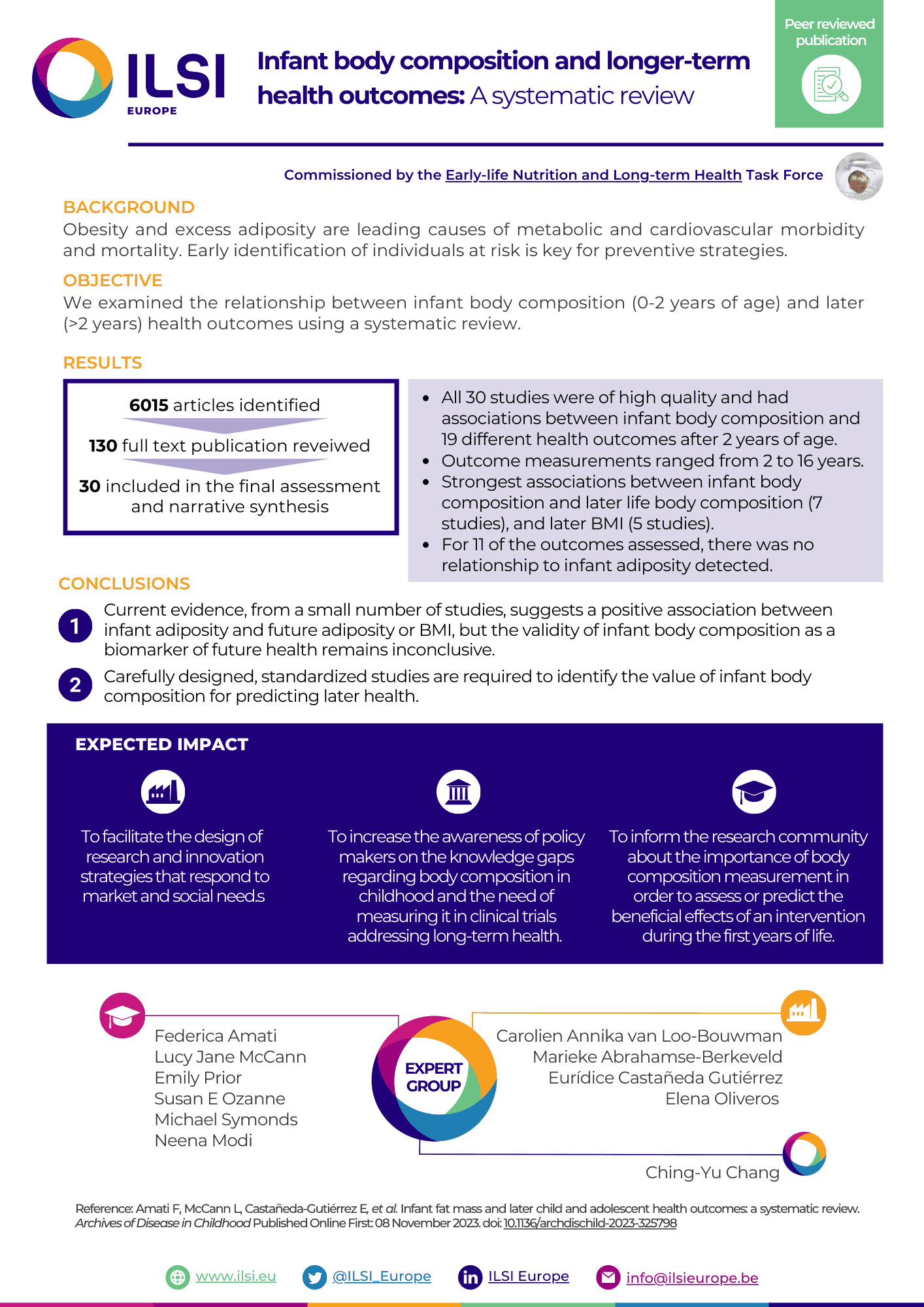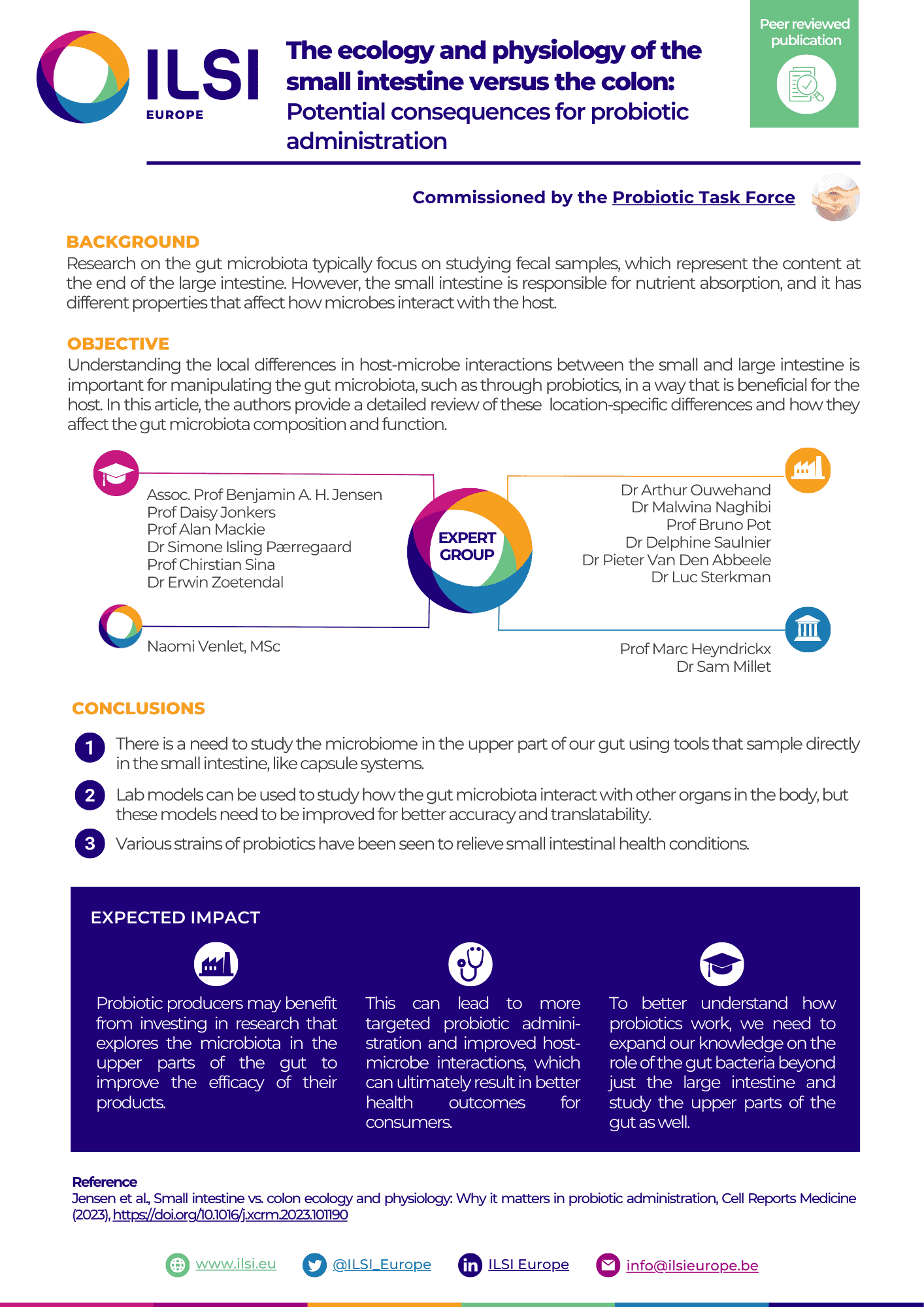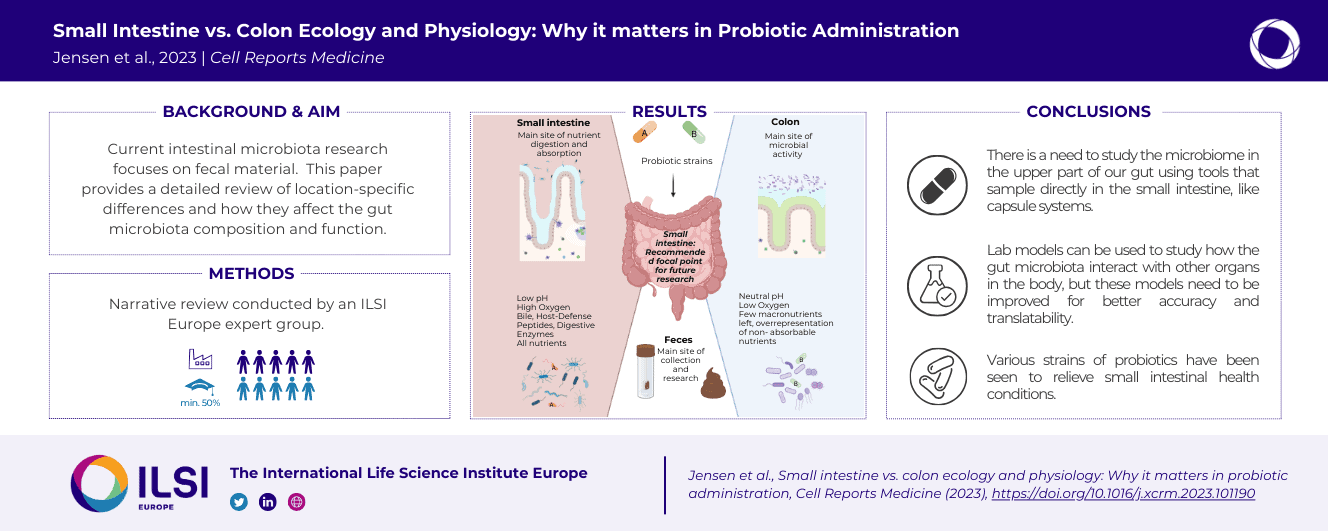Publication Date
All Publications
Infant fat mass and later child and adolescent health outcomes: a systematic review
Archives of Disease in Childhood, 2023
- ILSI Europe
Obesity and excess adiposity are leading causes of metabolic and cardiovascular morbidity and mortality. Early identification of individuals at risk is key for preventive strategies. We examined the relationship between infant body composition (0–2 years of age) and later (>2 years) health outcomes using a systematic review.
Small intestine vs. colon ecology and physiology: Why it matters in probiotic administration
Cell Reports Medicine, 2023
- ILSI Europe
We provide a detailed review unfolding how the physiological and anatomical differences between the small and large intestine affect gut microbiota composition, function, and plasticity. This information is key to understanding how gut microbiota manipulation, including probiotic administration, may strain-dependently transform host-microbe interactions at defined locations.
Impacts of the Ukraine–Russia Conflict on the Global Food Supply Chain and Building Future Resilience
EuroChoices, 2023
- ILSI Europe
The immediate concerns and potential solutions to the global impacts of the Ukraine–Russia conflict were recently discussed by a panel of industry, academic and civil society experts convened by the European branch of the International Life Sciences Institute, all of whom are authors of this manuscript.
Health relevance of lowering postprandial glycaemia in the paediatric population through diet’: results from a multistakeholder workshop
European Journal of Nutrition , 2022
- ILSI Europe
To summarize current knowledge and gaps regarding the role of postprandial glycaemic response in the paediatric population, a workshop was organized in June 2021 by the European branch of the International Life Science Institute (ILSI). The workshop led to the consensus on the crucial role on health of postprandial glycaemic response in paediatric population.
A systematic review of breast milk microbiota composition and the evidence for transfer to and colonisation of the infant gut
Beneficial Microbes, 2022
- ILSI Europe
he intestinal microbiota plays a major role in infant health and development. However, the role of the breastmilk microbiota in infant gut colonisation remains unclear. A systematic review was performed to evaluate the composition of the breastmilk microbiota and evidence for transfer to/colonisation of the infant gut
WP_Query Object
(
[query] => Array
(
[post_type] => publication
[posts_per_page] => 5
[type] => Journal Article
[area] =>
[committee] =>
[authors] =>
[showtitle] =>
[meta_query] => Array
(
[relation] => AND
[0] => Array
(
[key] => _ilsi_type
[value] => journal-article
[compare] => =
)
)
[tax_query] => Array
(
)
[paged] => 1
[meta_key] => _ilsi_date
[orderby] => meta_value
[order] => DESC
)
[query_vars] => Array
(
[post_type] => publication
[posts_per_page] => 5
[type] => Journal Article
[area] =>
[committee] =>
[authors] =>
[showtitle] =>
[meta_query] => Array
(
[relation] => AND
[0] => Array
(
[key] => _ilsi_type
[value] => journal-article
[compare] => =
)
)
[tax_query] => Array
(
)
[paged] => 1
[meta_key] => _ilsi_date
[orderby] => meta_value
[order] => DESC
[error] =>
[m] =>
[p] => 0
[post_parent] =>
[subpost] =>
[subpost_id] =>
[attachment] =>
[attachment_id] => 0
[name] =>
[pagename] =>
[page_id] => 0
[second] =>
[minute] =>
[hour] =>
[day] => 0
[monthnum] => 0
[year] => 0
[w] => 0
[category_name] =>
[tag] =>
[cat] =>
[tag_id] =>
[author] =>
[author_name] =>
[feed] =>
[tb] =>
[meta_value] =>
[preview] =>
[s] =>
[sentence] =>
[title] =>
[fields] =>
[menu_order] =>
[embed] =>
[category__in] => Array
(
)
[category__not_in] => Array
(
)
[category__and] => Array
(
)
[post__in] => Array
(
)
[post__not_in] => Array
(
)
[post_name__in] => Array
(
)
[tag__in] => Array
(
)
[tag__not_in] => Array
(
)
[tag__and] => Array
(
)
[tag_slug__in] => Array
(
)
[tag_slug__and] => Array
(
)
[post_parent__in] => Array
(
)
[post_parent__not_in] => Array
(
)
[author__in] => Array
(
)
[author__not_in] => Array
(
)
[search_columns] => Array
(
)
[ignore_sticky_posts] =>
[suppress_filters] =>
[cache_results] => 1
[update_post_term_cache] => 1
[update_menu_item_cache] =>
[lazy_load_term_meta] => 1
[update_post_meta_cache] => 1
[nopaging] =>
[comments_per_page] => 50
[no_found_rows] =>
)
[tax_query] => WP_Tax_Query Object
(
[queries] => Array
(
)
[relation] => AND
[table_aliases:protected] => Array
(
)
[queried_terms] => Array
(
)
[primary_table] => wp_3_posts
[primary_id_column] => ID
)
[meta_query] => WP_Meta_Query Object
(
[queries] => Array
(
[0] => Array
(
[key] => _ilsi_date
)
[1] => Array
(
[0] => Array
(
[key] => _ilsi_type
[value] => journal-article
[compare] => =
)
[relation] => OR
)
[relation] => AND
)
[relation] => AND
[meta_table] => wp_3_postmeta
[meta_id_column] => post_id
[primary_table] => wp_3_posts
[primary_id_column] => ID
[table_aliases:protected] => Array
(
[0] => wp_3_postmeta
[1] => mt1
)
[clauses:protected] => Array
(
[wp_3_postmeta] => Array
(
[key] => _ilsi_date
[compare] => =
[compare_key] => =
[alias] => wp_3_postmeta
[cast] => CHAR
)
[mt1] => Array
(
[key] => _ilsi_type
[value] => journal-article
[compare] => =
[compare_key] => =
[alias] => mt1
[cast] => CHAR
)
)
[has_or_relation:protected] =>
)
[date_query] =>
[request] =>
SELECT SQL_CALC_FOUND_ROWS wp_3_posts.ID
FROM wp_3_posts INNER JOIN wp_3_postmeta ON ( wp_3_posts.ID = wp_3_postmeta.post_id ) INNER JOIN wp_3_postmeta AS mt1 ON ( wp_3_posts.ID = mt1.post_id )
WHERE 1=1 AND (
wp_3_postmeta.meta_key = '_ilsi_date'
AND
(
( mt1.meta_key = '_ilsi_type' AND mt1.meta_value = 'journal-article' )
)
) AND ((wp_3_posts.post_type = 'publication' AND (wp_3_posts.post_status = 'publish' OR wp_3_posts.post_status = 'acf-disabled')))
GROUP BY wp_3_posts.ID
ORDER BY wp_3_postmeta.meta_value DESC
LIMIT 0, 5
[posts] => Array
(
[0] => WP_Post Object
(
[ID] => 13987
[post_author] => 351
[post_date] => 2023-11-09 08:52:48
[post_date_gmt] => 2023-11-09 08:52:48
[post_content] =>
Objective
Obesity and excess adiposity are leading causes of metabolic and cardiovascular morbidity and mortality. Early identification of individuals at risk is key for preventive strategies. We examined the relationship between infant body composition (0-2 years of age) and later (>2 years) health outcomes using a systematic review.
Design
We preregistered the study on PROSPERO (ID 288013) and searched Embase, PubMed and Cochrane databases for English language publications using the Medical Subject Headings (MeSH) terms 'infant' and 'body composition' and 'risk' between January 1946 and February 2022. We included studies which assessed infant body composition using predetermined in vivo methods other than body mass index (BMI).
Results
We identified 6015 articles. After abstract screening to assess eligibility, we reviewed 130 full text publications. 30 were included in the final assessment and narrative synthesis. Meta-analysis was not possible due to heterogeneity of results. All 30 studies were of high quality and reported associations between infant body composition and 19 different health outcomes after 2 years of age. Outcome measurements ranged from 2 years to 16 years. The strongest associations were found between infant fat mass and later fat mass (7 studies), and later BMI (5 studies). For 11 of the outcomes assessed, there was no relationship to infant adiposity detected.
Conclusions
Current evidence, from a small number of studies, suggests a positive association between infant adiposity and future adiposity or BMI, but the validity of infant body composition as a biomarker of future health remains inconclusive. Carefully designed, standardised studies are required to identify the value of infant body composition for predicting later health.
Download the full article here.
Download the article one-pager below
 [post_title] => Infant fat mass and later child and adolescent health outcomes: a systematic review
[post_excerpt] =>
[post_status] => publish
[comment_status] => closed
[ping_status] => closed
[post_password] =>
[post_name] => infant-fat-mass-and-later-child-and-adolescent-health-outcomes-a-systematic-review
[to_ping] =>
[pinged] =>
[post_modified] => 2024-03-15 15:13:16
[post_modified_gmt] => 2024-03-15 15:13:16
[post_content_filtered] =>
[post_parent] => 0
[guid] => https://ilsi.eu/?post_type=publication&p=13987
[menu_order] => 0
[post_type] => publication
[post_mime_type] =>
[comment_count] => 0
[filter] => raw
)
[1] => WP_Post Object
(
[ID] => 13549
[post_author] => 351
[post_date] => 2023-09-08 08:55:39
[post_date_gmt] => 2023-09-08 08:55:39
[post_content] =>
[post_title] => Infant fat mass and later child and adolescent health outcomes: a systematic review
[post_excerpt] =>
[post_status] => publish
[comment_status] => closed
[ping_status] => closed
[post_password] =>
[post_name] => infant-fat-mass-and-later-child-and-adolescent-health-outcomes-a-systematic-review
[to_ping] =>
[pinged] =>
[post_modified] => 2024-03-15 15:13:16
[post_modified_gmt] => 2024-03-15 15:13:16
[post_content_filtered] =>
[post_parent] => 0
[guid] => https://ilsi.eu/?post_type=publication&p=13987
[menu_order] => 0
[post_type] => publication
[post_mime_type] =>
[comment_count] => 0
[filter] => raw
)
[1] => WP_Post Object
(
[ID] => 13549
[post_author] => 351
[post_date] => 2023-09-08 08:55:39
[post_date_gmt] => 2023-09-08 08:55:39
[post_content] =>
Research on gut microbiota has generally focused on fecal samples, representing luminal content of the large intestine. However, nutrient uptake is restricted to the small intestine. Abundant immune cell populations at this anatomical site combined with diminished mucus secretion and looser junctions (partly to allow for more efficient fluid and nutrient absorption) also results in intimate host-microbe interactions despite more rapid transit. It is thus crucial to dissect key differences in both ecology and physiology between small and large intestine to better leverage the immense potential of human gut microbiota imprinting, including probiotic engraftment at biological sensible niches. Here, we provide a detailed review unfolding how the physiological and anatomical differences between the small and large intestine affect gut microbiota composition, function, and plasticity. This information is key to understanding how gut microbiota manipulation, including probiotic administration, may strain-dependently transform host-microbe interactions at defined locations.
This review focusses its narrative on the intimate relationship between the host and its bacterial constituents of the small and large intestine.
Dowload the full paper
or click on the images below to download the EG one-pager summary and graphical abstract


Commissioned by the Probiotics Task Force
[post_title] => Small intestine vs. colon ecology and physiology: Why it matters in probiotic administration
[post_excerpt] =>
[post_status] => publish
[comment_status] => closed
[ping_status] => closed
[post_password] =>
[post_name] => small-intestine-vs-colon-ecology-and-physiology-why-it-matters-in-probiotic-administration
[to_ping] =>
[pinged] =>
[post_modified] => 2023-09-08 12:36:10
[post_modified_gmt] => 2023-09-08 12:36:10
[post_content_filtered] =>
[post_parent] => 0
[guid] => https://ilsi.eu/?post_type=publication&p=13549
[menu_order] => 0
[post_type] => publication
[post_mime_type] =>
[comment_count] => 0
[filter] => raw
)
[2] => WP_Post Object
(
[ID] => 12507
[post_author] => 351
[post_date] => 2023-02-22 08:55:39
[post_date_gmt] => 2023-02-22 08:55:39
[post_content] =>
[post_title] => Impacts of the Ukraine–Russia Conflict on the Global Food Supply Chain and Building Future Resilience
[post_excerpt] =>
[post_status] => publish
[comment_status] => closed
[ping_status] => closed
[post_password] =>
[post_name] => impacts-of-the-ukraine-russia-conflict-on-the-global-food-supply-chain-and-building-future-resilience
[to_ping] =>
[pinged] =>
[post_modified] => 2023-06-19 12:44:01
[post_modified_gmt] => 2023-06-19 12:44:01
[post_content_filtered] =>
[post_parent] => 0
[guid] => https://ilsi.eu/?post_type=publication&p=12507
[menu_order] => 0
[post_type] => publication
[post_mime_type] =>
[comment_count] => 0
[filter] => raw
)
[3] => WP_Post Object
(
[ID] => 12345
[post_author] => 24
[post_date] => 2023-01-04 12:00:18
[post_date_gmt] => 2023-01-04 12:00:18
[post_content] =>
[post_title] => Health relevance of lowering postprandial glycaemia in the paediatric population through diet’: results from a multistakeholder workshop
[post_excerpt] =>
[post_status] => publish
[comment_status] => closed
[ping_status] => closed
[post_password] =>
[post_name] => health-relevance-of-lowering-postprandial-glycaemia-in-the-paediatric-population-through-diet-results-from-a-multistakeholder-workshop
[to_ping] =>
[pinged] =>
[post_modified] => 2023-06-19 12:46:23
[post_modified_gmt] => 2023-06-19 12:46:23
[post_content_filtered] =>
[post_parent] => 0
[guid] => https://ilsi.eu/?post_type=publication&p=12345
[menu_order] => 0
[post_type] => publication
[post_mime_type] =>
[comment_count] => 0
[filter] => raw
)
[4] => WP_Post Object
(
[ID] => 12225
[post_author] => 24
[post_date] => 2022-11-15 14:24:37
[post_date_gmt] => 2022-11-15 14:24:37
[post_content] =>
The intestinal microbiota plays a major role in infant health and development. However, the role of the breastmilk microbiota in infant gut colonisation remains unclear. A systematic review was performed to evaluate the composition of the breastmilk microbiota and evidence for transfer to/colonisation of the infant gut. Searches were performed using PUBMED, OVID, LILACS and PROQUEST from inception until 18th March 2020 with a PUBMED update to December 2021. 88 full texts were evaluated before final critique based on study power, sample contamination avoidance, storage, purification process, DNA extraction/analysis, and consideration of maternal health and other potential confounders. Risk of skin contamination was reduced mainly by breast cleaning and rejecting the first milk drops. Sample storage, DNA extraction and bioinformatics varied. Several studies stored samples under conditions that may selectively impact bacterial DNA preservation, others used preculture reducing reliability. Only 15 studies, with acceptable sample size, handling, extraction, and bacterial analysis, considered transfer of bacteria to the infant. Three reported bacterial transfer from infant to breastmilk. Despite consistent evidence for the breastmilk microbiota, and recent studies using improved methods to investigate factors affecting its composition, few studies adequately considered transfer to the infant gut providing very little evidence for effective impact on gut colonisation.
Keywords
Expand
Microbiota, infant, breast milk, gut colonisation, systematic review
To download this open-access article, please click here.
Commissioned by the Early Nutrition and Long-Term Health Task Force.
[post_title] => A systematic review of breast milk microbiota composition and the evidence for transfer to and colonisation of the infant gut
[post_excerpt] =>
[post_status] => publish
[comment_status] => closed
[ping_status] => closed
[post_password] =>
[post_name] => a-systematic-review-of-breast-milk-microbiota-composition-and-the-evidence-for-transfer-to-and-colonisation-of-the-infant-gut
[to_ping] =>
[pinged] =>
[post_modified] => 2023-06-19 12:47:12
[post_modified_gmt] => 2023-06-19 12:47:12
[post_content_filtered] =>
[post_parent] => 0
[guid] => https://ilsi.eu/?post_type=publication&p=12225
[menu_order] => 0
[post_type] => publication
[post_mime_type] =>
[comment_count] => 0
[filter] => raw
)
)
[post_count] => 5
[current_post] => -1
[before_loop] =>
[in_the_loop] =>
[post] => WP_Post Object
(
[ID] => 13987
[post_author] => 351
[post_date] => 2023-11-09 08:52:48
[post_date_gmt] => 2023-11-09 08:52:48
[post_content] =>
Objective
Obesity and excess adiposity are leading causes of metabolic and cardiovascular morbidity and mortality. Early identification of individuals at risk is key for preventive strategies. We examined the relationship between infant body composition (0-2 years of age) and later (>2 years) health outcomes using a systematic review.
Design
We preregistered the study on PROSPERO (ID 288013) and searched Embase, PubMed and Cochrane databases for English language publications using the Medical Subject Headings (MeSH) terms 'infant' and 'body composition' and 'risk' between January 1946 and February 2022. We included studies which assessed infant body composition using predetermined in vivo methods other than body mass index (BMI).
Results
We identified 6015 articles. After abstract screening to assess eligibility, we reviewed 130 full text publications. 30 were included in the final assessment and narrative synthesis. Meta-analysis was not possible due to heterogeneity of results. All 30 studies were of high quality and reported associations between infant body composition and 19 different health outcomes after 2 years of age. Outcome measurements ranged from 2 years to 16 years. The strongest associations were found between infant fat mass and later fat mass (7 studies), and later BMI (5 studies). For 11 of the outcomes assessed, there was no relationship to infant adiposity detected.
Conclusions
Current evidence, from a small number of studies, suggests a positive association between infant adiposity and future adiposity or BMI, but the validity of infant body composition as a biomarker of future health remains inconclusive. Carefully designed, standardised studies are required to identify the value of infant body composition for predicting later health.
Download the full article here.
Download the article one-pager below
 [post_title] => Infant fat mass and later child and adolescent health outcomes: a systematic review
[post_excerpt] =>
[post_status] => publish
[comment_status] => closed
[ping_status] => closed
[post_password] =>
[post_name] => infant-fat-mass-and-later-child-and-adolescent-health-outcomes-a-systematic-review
[to_ping] =>
[pinged] =>
[post_modified] => 2024-03-15 15:13:16
[post_modified_gmt] => 2024-03-15 15:13:16
[post_content_filtered] =>
[post_parent] => 0
[guid] => https://ilsi.eu/?post_type=publication&p=13987
[menu_order] => 0
[post_type] => publication
[post_mime_type] =>
[comment_count] => 0
[filter] => raw
)
[comment_count] => 0
[current_comment] => -1
[found_posts] => 320
[max_num_pages] => 64
[max_num_comment_pages] => 0
[is_single] =>
[is_preview] =>
[is_page] =>
[is_archive] =>
[is_date] =>
[is_year] =>
[is_month] =>
[is_day] =>
[is_time] =>
[is_author] =>
[is_category] =>
[is_tag] =>
[is_tax] =>
[is_search] =>
[is_feed] =>
[is_comment_feed] =>
[is_trackback] =>
[is_home] => 1
[is_privacy_policy] =>
[is_404] =>
[is_embed] =>
[is_paged] =>
[is_admin] =>
[is_attachment] =>
[is_singular] =>
[is_robots] =>
[is_favicon] =>
[is_posts_page] =>
[is_post_type_archive] =>
[query_vars_hash:WP_Query:private] => bfe316542b5cae6cce5db04976373270
[query_vars_changed:WP_Query:private] =>
[thumbnails_cached] =>
[allow_query_attachment_by_filename:protected] =>
[stopwords:WP_Query:private] =>
[compat_fields:WP_Query:private] => Array
(
[0] => query_vars_hash
[1] => query_vars_changed
)
[compat_methods:WP_Query:private] => Array
(
[0] => init_query_flags
[1] => parse_tax_query
)
)
[post_title] => Infant fat mass and later child and adolescent health outcomes: a systematic review
[post_excerpt] =>
[post_status] => publish
[comment_status] => closed
[ping_status] => closed
[post_password] =>
[post_name] => infant-fat-mass-and-later-child-and-adolescent-health-outcomes-a-systematic-review
[to_ping] =>
[pinged] =>
[post_modified] => 2024-03-15 15:13:16
[post_modified_gmt] => 2024-03-15 15:13:16
[post_content_filtered] =>
[post_parent] => 0
[guid] => https://ilsi.eu/?post_type=publication&p=13987
[menu_order] => 0
[post_type] => publication
[post_mime_type] =>
[comment_count] => 0
[filter] => raw
)
[comment_count] => 0
[current_comment] => -1
[found_posts] => 320
[max_num_pages] => 64
[max_num_comment_pages] => 0
[is_single] =>
[is_preview] =>
[is_page] =>
[is_archive] =>
[is_date] =>
[is_year] =>
[is_month] =>
[is_day] =>
[is_time] =>
[is_author] =>
[is_category] =>
[is_tag] =>
[is_tax] =>
[is_search] =>
[is_feed] =>
[is_comment_feed] =>
[is_trackback] =>
[is_home] => 1
[is_privacy_policy] =>
[is_404] =>
[is_embed] =>
[is_paged] =>
[is_admin] =>
[is_attachment] =>
[is_singular] =>
[is_robots] =>
[is_favicon] =>
[is_posts_page] =>
[is_post_type_archive] =>
[query_vars_hash:WP_Query:private] => bfe316542b5cae6cce5db04976373270
[query_vars_changed:WP_Query:private] =>
[thumbnails_cached] =>
[allow_query_attachment_by_filename:protected] =>
[stopwords:WP_Query:private] =>
[compat_fields:WP_Query:private] => Array
(
[0] => query_vars_hash
[1] => query_vars_changed
)
[compat_methods:WP_Query:private] => Array
(
[0] => init_query_flags
[1] => parse_tax_query
)
)